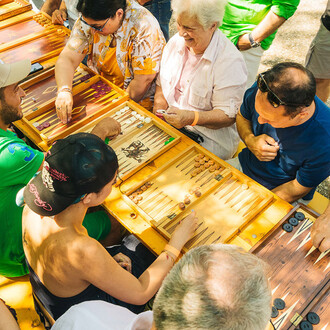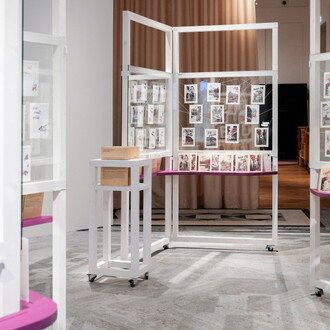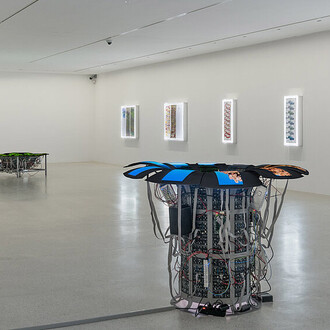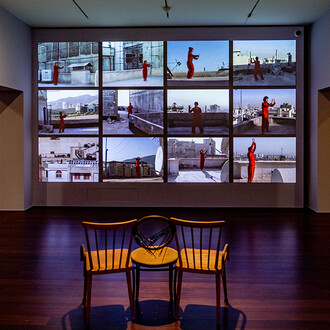Kiki Kogelnik, who passed away almost exactly twenty years ago, on February 1st 1997, staged her artificial appearance as part of a complex artistic overall strategy that focussed on the inseparable connection of life and art. Quite naturally, the multifaceted, versatile artist attached the same importance to the performative “self imaging“ and “self fashioning“ as to her artistic work, which explicitly cannot be reduced to disciplines and categories. “Kiki is an original. Her style is part bohemian, part film star, part intellectual” Robert Fulford stated in the “Toronto Daily Star“ in 1964.
In 1962, Kiki Kogelnik, who had been a stranger to all provincial, chauvinist or bourgeois throughout her life, left the depressing postwar Europe and moved to the pulsating urbanity of the art metropolis that was New York. In 1959, Kogelnik had met her charismatic fellow artist Sam Francis, who was able to persuade her to take this chance that would eventually become crucial for her work. Influenced by American pop art and French nouveau réalisme and in close vicinity to the studios of Andy Warhol, Roy Lichtenstein, Robert Rauschenberg, Jasper Johns and Claes Oldenburg on Broadway, Kiki Kogelnik could virtually unconditionally indulge in her blatant enthusiasm for technical progress, aerospace and the commercial world in an almost childlike, sensual curiosity. Kogelnik confronted sociopolitically dubious aspects with ironic, or even self-ironic ambiguity – one need only think of the colourfully painted bomb cylinders from the early 1960s, discarded from army inventories. Kiki Kogelnik’s expressive, gestural art of painting, the abstract, informal compositions of her early artistic years that show the firm anchoring in the avantgardistic Galerie nächst St. Stephan gallery, directed by Monseigneur Otto Mauer, would soon be replaced by an increasingly collage and assemblage-like method.
Kogelnik came upon “space art“, her subjective version of pop art, and in 1962, she began to create “cut-outs“ of artist friends, life-size figures cut out of brown packing paper. Hung on a coat hook or a clothing rack, in 1967, these would result in her colourful, pictograph vinyl “hangings“.
Kogelnik’s virtuoso handling of the scissors, her humorous and unconventional play with stencils, silhouettes and a sensitively constructed repertoire of versatile, pre-fabricated picture components (body fragments, tool parts, protagonists of the animal world such as snakes, frogs, ants or bugs) would eventually culminate in the creative device of the mask-like physiognomy – which can be read as a crypto- or self-portrait of the artist – with a significantly jagged shock of hair and cut out eyes and mouths that are always open wide; this has long become Kiki Kogelnik’s unmistakable, emblematic trademark. In a diary entry from 3rd April 1975, Kogelnik wrote “Sam [= Sam Francis] said some very good things about my paintings. About all of them being like a self-portrait.“
The large-scale oil paintings and the hereto referring screen prints of the 1970s and early 1980s (“Women’s Lib“) show bold female figures from the world of advertising and fashion in eccentric poses, “sophisticated, cool and unattached”. Kogelnik vividly questioned female clichés and beauty ideals, and critically screened living environments and lifestyle sceneries.
In 1974, Kiki Kogelnik created her first ceramic sculptures in bright colours – full round, colourful women’s heads with circular eyes or sunglasses, ceramic equivalents of her women’s portraits of the “Women´s Lib“ period. “I have a strong connection to sculpture and three-dimensionality”, the artist noted in 1996. As she would never learn the art of turning clay on a pottery wheel, Kiki Kogelnik did not waste time turning towards also adapting the use of stencils – a practice common in painting since the early 1960s – in her ceramic work. Kogelnik rolled out the clay like gingerbread dough, two to three centimetres thick, and used a knife to cut the stencil contours, previously put onto the rolled out dough. “Masks“, faces without mimicry, no portraits, are the dominant subject on her ceramic image carriers. Colourful glazes would finally complete the entirely unique ceramic works. Subsequently, Kiki Kogelnik’s paintings were given “Expansions” in the form of ceramic „Falling-outs”; the artist would negate the limits of the canvas, expanding the two-dimensionality inherent in the images with a three-dimensional component.
Kiki Kogelnik’s manifold pictorial oeuvre passionately fathomed possibilities of medial – performance, painting, three-dimensional objects – and material aesthetics – ceramics, glass, bronze, vinyl – with an attitude that anticipates the zeitgeist and contemporary discourses. Her work found its widely appreciated expression in the colourful, expressive, luminous glass heads, i.e. the series of “Venetian Heads“, “Little Heads“ and “Balloon Heads“, crafted in Murano after 1994. It was with a creative lightness that Kogelnik transformed the water from the Venice lagoon into incomparable glass objects of a metamorphic fascination, chromatic brightness and inimitable elegance or rather transparence of the form.
Kiki Kogelnik’s singular oeuvre persistently defies all categorisation and art historical labelling. Hence, Tom Wesselmann’s conclusion, “She was not Pop, she was strictly Kiki.”
















